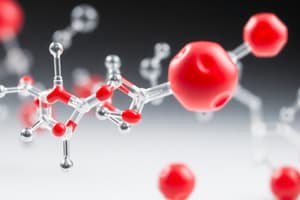Podcast
Questions and Answers
What is enzyme inhibition?
What is enzyme inhibition?
Enzyme inhibition is a process that decreases or stops the activity of an enzyme.
What are the two main types of enzyme inhibition?
What are the two main types of enzyme inhibition?
- Reversible and irreversible
- Direct and indirect
- Competitive and non-competitive (correct)
- Active and inactive
Competitive inhibitors bind to the active site of the enzyme.
Competitive inhibitors bind to the active site of the enzyme.
True (A)
Non-competitive inhibitors can be relieved by increasing substrate concentration.
Non-competitive inhibitors can be relieved by increasing substrate concentration.
Which of the following is NOT a characteristic of competitive inhibition?
Which of the following is NOT a characteristic of competitive inhibition?
Which of the following is a characteristic of non-competitive inhibition?
Which of the following is a characteristic of non-competitive inhibition?
What is the drug allopurinol used for?
What is the drug allopurinol used for?
How does dicumarol work?
How does dicumarol work?
Match the following enzyme inhibitors with their mechanism of action:
Match the following enzyme inhibitors with their mechanism of action:
Flashcards
What is enzyme inhibition?
What is enzyme inhibition?
Enzyme activity can be regulated by decreasing or stopping its function.
What is an inhibitor?
What is an inhibitor?
A substance that reduces or eliminates the rate of enzyme activity.
Describe competitive inhibition.
Describe competitive inhibition.
A type of reversible inhibition where the inhibitor and substrate compete for the same catalytic site on the enzyme.
What's the key characteristic of a competitive inhibitor?
What's the key characteristic of a competitive inhibitor?
Signup and view all the flashcards
Is competitive inhibition reversible?
Is competitive inhibition reversible?
Signup and view all the flashcards
How does competitive inhibition affect Vmax and Km?
How does competitive inhibition affect Vmax and Km?
Signup and view all the flashcards
Describe non-competitive inhibition.
Describe non-competitive inhibition.
Signup and view all the flashcards
What makes non-competitive inhibitors different from competitive ones?
What makes non-competitive inhibitors different from competitive ones?
Signup and view all the flashcards
Is non-competitive inhibition reversible?
Is non-competitive inhibition reversible?
Signup and view all the flashcards
How does non-competitive inhibition affect Vmax and Km?
How does non-competitive inhibition affect Vmax and Km?
Signup and view all the flashcards
How can heavy metals inhibit enzymes?
How can heavy metals inhibit enzymes?
Signup and view all the flashcards
How can cofactors be inhibited?
How can cofactors be inhibited?
Signup and view all the flashcards
How does cyanide inhibit cytochrome oxidase?
How does cyanide inhibit cytochrome oxidase?
Signup and view all the flashcards
How can metal ion activators be inhibited?
How can metal ion activators be inhibited?
Signup and view all the flashcards
What is allopurinol used for and how does it work?
What is allopurinol used for and how does it work?
Signup and view all the flashcards
What is dicumarol used for and how does it work?
What is dicumarol used for and how does it work?
Signup and view all the flashcards
How do sulfonamides work as antibiotics?
How do sulfonamides work as antibiotics?
Signup and view all the flashcards
How can ethanol help in methanol poisoning?
How can ethanol help in methanol poisoning?
Signup and view all the flashcards
What are irreversible inhibitors?
What are irreversible inhibitors?
Signup and view all the flashcards
Explain competitive inhibition.
Explain competitive inhibition.
Signup and view all the flashcards
Explain non-competitive inhibition.
Explain non-competitive inhibition.
Signup and view all the flashcards
How does competitive inhibition affect Vmax and Km?
How does competitive inhibition affect Vmax and Km?
Signup and view all the flashcards
How does non-competitive inhibition affect Vmax and Km?
How does non-competitive inhibition affect Vmax and Km?
Signup and view all the flashcards
What is the effect of irreversible inhibitors on enzymes?
What is the effect of irreversible inhibitors on enzymes?
Signup and view all the flashcards
Can competitive inhibition be overcome?
Can competitive inhibition be overcome?
Signup and view all the flashcards
Can non-competitive inhibition be overcome?
Can non-competitive inhibition be overcome?
Signup and view all the flashcards
What is a key characteristic of competitive inhibitors?
What is a key characteristic of competitive inhibitors?
Signup and view all the flashcards
What is a key characteristic of non-competitive inhibitors?
What is a key characteristic of non-competitive inhibitors?
Signup and view all the flashcards
Study Notes
Enzyme Inhibition
- Enzyme inhibition is a process that decreases or stops enzyme activity.
- Inhibitors are substances that reduce or abolish the rate of enzyme action.
- Inhibition types are categorized based on the similarity between the inhibitor and the substrate:
- Competitive Inhibition: Involves structural similarity between the inhibitor and the substrate. The inhibitor and substrate compete to bind to the enzyme's catalytic site. This inhibition is reversible. Increasing substrate concentration can reverse the inhibition. It doesn't affect the maximum reaction rate (Vmax), but increases the Michaelis constant (Km).
- Non-competitive Inhibition: The inhibitor lacks structural similarity with the substrate. It binds to a different site on the enzyme, changing its shape and hindering enzyme activity; this is an irreversible process. Increasing substrate concentration does not reverse the inhibition. This inhibition decreases the maximum reaction rate (Vmax), but does not change the Michaelis constant (Km).
Examples and Clinical Use
- Folic acid synthesis: Sulfonilamide inhibits dihydropteroate synthase (DHPS).
- Prothrombin synthesis: Dicumarol inhibits vitamin K epoxide reductase.
- Xanthine oxidase: Allopurinol inhibits xanthine oxidase, which is involved in the formation of uric acid.
- Alcohol dehydrogenase: Ethanol is an example of an inhibitor that converts to acetaldehyde.
Inhibition of Specific Groups
- Sulphahydryl (-SH) group: Many enzymes depend on free SH groups. Heavy metals like mercury (Hg++) and lead (Pb++) inhibit these groups.
- Cofactors: Cyanide hydrazine inhibits coenzyme pyridoxal phosphate (PLP).
- Metal ion activators: Oxalate chelates calcium ions, preventing blood clotting. Fluoride chelates magnesium ions, inhibiting glycolysis.
Case Studies
- Gout: Allopurinol inhibits xanthine oxidase which is involved in the formation of uric acid (urate).
- Ischemic heart disease: Dicumarol inhibits a coagulation enzyme to thin the blood.
Studying That Suits You
Use AI to generate personalized quizzes and flashcards to suit your learning preferences.




